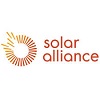
Solar Alliance launches new product named Renewable Radar
 By Tom Ballard, Chief Alliance Officer, PYA
By Tom Ballard, Chief Alliance Officer, PYA
“We’re the engineering and construction side of the business,” Harvey Abouelata says of the component of Solar Alliance Energy Inc., a Vancouver-based company that is located in South Knoxville.
The local operation, which started as ARiES Energy before going through two acquisitions, just launched a new product called the Renewable Radar. Those two words clearly describe the focus – an initial snapshot of a company’s energy expenses and an on-going analysis as factors contributing to the costs change.
Abouelata, the company’s Vice President for Commercial Solar, said the Renewable Radar was developed in response to the needs of a Fortune 500 client.
“Anyone with multiple brick and mortar assets can benefit from the tool,” he says. “You have zillions of variables driving your energy costs. We evaluate all of those things and find the low hanging fruit.”
The variables include everything from geography and weather to state policies and utility practices like time of day charging. There’s also a rapidly emerging area.
“Distributed power is going to be really disruptive,” Abouelata says. “People who have already prepared will be ready for the inevitable. The curve is going to change all over the country in different ways and times.”
Solar-generated power is just one of a number of technologies that companies are increasingly using to generate a portion of their own electricity. As more of those installations occur, utility systems are seeing declines in energy consumption, impacting the fixed costs they have incurred to build large power plants. Policy changes and rate adjustments are inevitable.
Renewable Radar is designed to help companies navigate those uncertain waters, providing an energy baseline for a company so that it can identify and evaluate various opportunities and options. Abouelata says it can provide an analysis for a single location or, in the case of the Fortune 500 client for which the tool was developed, facilities over a broad geographic footprint.
“Renewable Radar is flexible and can be scaled to meet needs,” he emphasizes.
Solar Alliance starts by creating a baseline of a company’s energy needs. Factors that go into creating the baseline include plant physical size; roof space and roof conditions; electrical usage and profile; utility rate schedules and other considerations like time of day and demand charges; federal, state and utility incentives; and emissions accounting.
Once all the data are compiled, Abouelata says Solar Alliance works to align what is conceivable technically with the enterprise’s goals. A conceptual design and model is developed. All of the opportunities that are possible are identified and ranked based on payback and the client’s objectives. Then, the optimal strategy is presented.
“We are looking for what gives the client the best ROI,” Abouelata explains. In California, it might be solar and battery storage, while in neighboring Arizona, the optimal combination could be a continuous-run generator and solar.
“It’s not a cookie cutter approach,” he adds.
Once the client signs-off on the plan, Solar Alliance starts implementing it, but the latter’s environmental scanning does not end even as the work begins. In fact, it is an ongoing process that could require changes to the design.
“If a utility implements a different billing practice such as increasing demand charges, we will adjust the design,” Abouelata says. The same holds true for other items like changes in the energy profile of a plant and new or altered incentive programs.
Once a project is completed, Solar Alliance stays with the client to help it make future changes as factors change.
“We monitor 80 percent of our clients’ systems,” Abouelata says, providing feedback from its ongoing Renewable Radar.
For about a decade, the graduate of Rochester Institute of Technology has been focused on the energy sector, building increasingly larger and more complex projects. One of his favorite clients has been Ted Wampler and Wampler’s Farm Sausage. The latest project installation brought the total to more than 680 kW of PV solar panels at the plant (see our recent post). Along the way. ARiES won the “Traction Award” in the 2015 “Start-up Day Knoxville” competition.
With more deep-pocketed owners, Abouelata sees other positive changes coming to the division of Solar Alliance that he leads. A new sales and marketing process has filled the funnel, particularly in the usually slow first quarter of every calendar year. There’s also a new residential product offering the company has just started rolling-out exclusively for builders.


